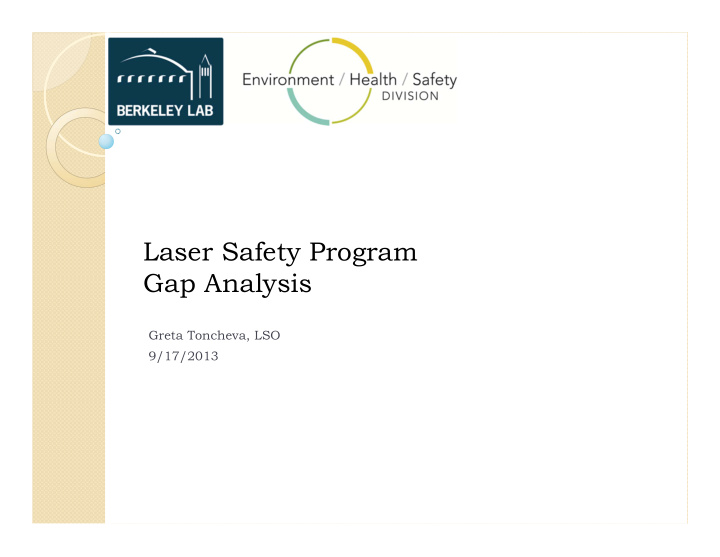



Laser Safety Program Gap Analysis Greta Toncheva, LSO 9/17/2013
Laser Gap Analysis Purpose: T o evaluate the existing laser safety program for compliance with the design and control requirements of 10 CFR 851Worker Safety and Health Program and incorporated references, specifically ANSI Z136.1 – 2000. • Conducted from March 2013 through June 2013 • A 313-question checklist was developed • A desk top comparison of documents was completed, each area reviewed for compliance ES&H Manual (Former Pub. 3000), Chapter 16 10 CFR 851, Worker Safety and Health Program 29 CFR 1910, Industrial Safety Standard 29 CFR 1926, Construction Safety Standard ANSI Z136.1 - 2000, Safe Use of Lasers ACGIH TLVs and BEIs – 2005
Results Compliance: Overall the laser safety program is compliant with the ANSI Z136.1 – 2000 and provides the degree of control which is commensurate with the existing and potential hazards related to laser beam. The gap analysis aided in documenting areas of LBL’s program that need developing, strengthening and implementing
Risk The GAPs were risk ranked based on: ORPS severity, occurrence frequency and detection ability, which resulted in the following three groups: High risk gaps: - UV laser protection control and PPE - Unattended laser use controls - Rapid egress under emergency conditions - “Panic Button” for emergencies - Protective housing labeling - Walk-in protective housing controls - Control measures for the hearing and visually impaired - Laser interlock program - Laser robotic installations, mechanical hazard - Explosion hazard (high pressure lamps, filament lamps, capacitor banks)
Risk – Cont. Medium risk gaps: - Viewing windows, collecting optics interlocks, filters, and attenuators - Facility windows, screens, and barriers requirements for laser protection; flame retardant materials - Laser generated air contaminants (LGAC) and respiratory protection - Warning signs for other non-beam hazard - Labels with laser classification and maximum output - Collateral UV emitted from laser discharge tubes and pumps shielding - Waste disposal - Laser pointers limits - Laser classification by the LSO - Laser use in construction Low risk gaps: - Record keeping, follow up on corrective actions - Training authorizations, qualifications for a laser safety trainer - Controls for outdoor laser use - Laser demonstrations involving general public - Laser output measurement for the purpose of evaluation and classification - Laser classification or verification by the LSO (Class 1) - Laser optical fiber transmission system - Limited work space, ventilation, ergonomics
Compliance Gaps fall into three categories: The controls are implemented or partially implemented, but not well • documented in the program “Panic Button” for emergencies Laser interlock program Viewing windows, collecting optics interlocks, filters, and attenuators Facility windows, screens, and barriers requirements for laser protection; flame retardant materials The controls are not implemented, not documented, but not existing at LBNL • Laser robotic installations, mechanical hazard Controls for outdoor laser use Laser demonstrations involving general public The controls are not implemented and not documented • Construction lasers – need to evaluate if we are in non-compliance Control measures for the hearing and visually impaired
Closing the Gaps Steps for Implementation: • Benchmark study of 3 other DOE labs • Develop a high level laser safety program document that implements laser safety in accordance with ANSI Z136.1: Update ES&H Manual (Former Pub. 3000), Chapter 16 Review the existing protocols and roll them into Chapter 16 Update Laser safety web-page • Evaluate all AHDs with laser schedules, using the program developed in the step above, to assess and correct potential gaps
Projected Time for Implementation Benchmark the laser safety program of other DOE laboratories – • 3 months Revision of the program and updating Chapter 16 – 15 months • Evaluating laser AHDs and correcting the possible gaps – 12 • months Projected completion of the project – December 31, 2015 RPG staff responsible for implementation: LSO with assistance of the DLSO
Thank You
Risk Ranked Gaps ORPS Occurrence Detection Severity Frequency Ability Result UV laser protection control and PPE 1 2 3 6 Unattended laser use controls 2 3 2 12 Rapid egress under emergency conditions 2 2 3 12 “Panic Button” for Emergencies 2 2 3 12 Protective housing labeling 2 2 3 12 Walk-in protective housing controls 1 4 4 16 Control measures for the hearing and visually impaired 1 4 4 16 Laser interlock program 1 4 4 16 Laser robotic installations, mechanical hazard 1 4 4 16 Explosion hazard (high pressure lamps, filament lamps, capacitor banks) 1 4 4 16 Viewing windows, collecting optics 3 2 3 18 Facility windows, screens, barriers requirements for laser protection; flame retardant materials 2 3 3 18 Laser generated air contaminants (LGAC), respiratory protection 2 3 3 18 Warning signs for other non-beam hazard 3 3 3 27 Labels with classification and max output 3 3 3 27 Collateral UV emitted from laser discharge tubes and pumps shielding 3 3 3 27 Waste disposal 3 3 3 27 Laser pointers’ limits 4 4 2 32 Laser classification or verify classification by the LSO (Class 1) 4 3 3 36 Laser use in construction 4 4 3 48 Record keeping, follow up on corrective actions 4 4 4 64 Training authorizations, qualifications for a laser safety trainer 4 4 4 64 Controls for outdoor laser use 4 4 4 64 Laser demonstrations involving general public 4 4 4 64 Laser output measurement for the purpose of evaluation and classification 4 4 4 64 Laser classification by the LSO 4 4 4 64 Laser optical fiber transmission system 4 4 4 64 Limited work space, ventilation, ergonomics 4 4 4 64
Recommend
More recommend